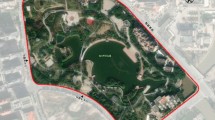Abstract
A procedure for evaluating different areas as national parks based on a scoring system is proposed. A National Park Evaluation Form (NPEF) evaluating natural, cultural, and recreational resources in accordance with international criteria for national parks is presented. The evaluation points given to an area indicate the possibility of the area becoming a national park. In this method, subjectivity and bias have been minimized by a special application of the Delphi technique. The method outlined here could help in the efforts of selecting and establishing national parks in many countries.
Similar content being viewed by others
Literature Cited
Anonymous. 1978a. Peak District national park plan. Peak Park Joint Planning Board, Derbyshire, England, 192 pp.
Anonymous. 1978b. Lake District national park plan. Lake District Special Planning Board, Cumbria, England, 201 pp.
Anselin, A., P. M. Meire, and L. Anselin. 1989. Multicriteria techniques in ecological evaluation: An example using the analytical hierarchy process.Biological Conservation 49:215–229.
Chapman, S. B., R. T. Clarke, and N. R. Webb. 1989. Survey and assessment of heathland in Dorset, England, for conservation.Biological Conservation 47:137–152.
Clarke, J. E., and R. H. V. Bell 1986. Representation of biotic communities in protected areas: A Malawian case study.Biological Conservation 35:293–311.
Coburn, B. A. 1984 Sagarmatha: Managing a Himalayan world heritage site.Parks 9(2):10–13.
Dony, J. G., and I. Denholm. 1985. Some quantitative methods of assessing the conservation values of ecologically similar sites.Journal of Applied Ecology 22:229–238.
Goldsmith, F. B. 1987. Slection procedures for forest nature reserves in Nova Scotia, Canada.Biological Conservation 41:185–201.
Green, D. H., and G. J. Hunter. 1991. Environmental impact and tourism developments. Pages 313–331in Z. Yenen, (ed.), International symposium on architecture of tourism in the Mediterranean, Vol. 2, Proceedings 1. Yildiz University, Istanbul.
Green, D. H., C. J. Hunter, and B. Moore. 1990. Application of the Delphi technique in tourism.Annals of Tourism Research 17:270–279.
Hicks, I. 1982. Christmas Island-a new Australian national park.Parks 7(1):1–4.
IUCN. 1978. Categories, objectives and criteria for protected areas. IUCN, Morges, Switzerland, 26 pp.
IUCN. 1980. 1980 United Nations list of national parks and equivalent reserves. IUCN, Gland, Switzerland, 121 pp.
Kashani, R. B. 1989. A new method for site suitability analysis: The analytic hierarchy process.Environmental Management 13:685–693.
Korça, P. 1991. Assessment of environmental impacts on tourism. Pages 357–368in Z. Yenen, (ed.), International symposium on architecture of tourism in the Mediterranean, Vol. 2, Proceedings 1. Yildiz University, Istanbul.
Lindstone, A. H., and M. Turoff (eds.). 1975. The Delphi method: Techniques and applications. Addison-Wesby Publishing, Reading, Massachusetts.
Margules, C. R. 1986. Conservation evaluation in practice. Pages 297–314in M. B. Usher. (ed), Wildlife conservation evaluation. Chapman and Hall, London.
Margules, C. R. 1989. Introduction to some Australian developments in conservation evaluation.Biological Conservation 50:1–11.
Margules, C. R., and M. B. Usher. 1981. Criteria used in assessing wildlife conservation potential: A review,Biological Conservation 21:79–109.
Masser, I., and P. Foley. 1987. Delphi revisited: Expert opinion in urban analysis.Urban Studies 24:217–225.
McKenzie, N. L., L. Belbin, C. R. Margules, and G. J. Keighery. 1989. Selecting representative reserve systems in remote areas: a case study in the Nullarbor regions, Australia.Biological Conservation 50:239–261.
Miller, A., and W. Cuff. 1986. The Delphi approach to the mediation of environmental disputes.Environmental Management 10:321–330.
Monfort, A., and N. Monfort. 1984. Akegara: Rwanda's largest national park.Parks 8(4):6–8.
Nilsson, C. 1986. Methods of selecting lake shorelines in nature reserves.Biological Conservation 35:269–291.
Parks Canada. 1979. Parks Canada Policy. Department of the Environment. Ottawa, 69 pp.
Phillips, A. 1985. Socio-economic development in the “national parks” of England and Wales,Parks 10(1):1–5.
Philipson, J. (ed.). 1969. Northumberland national park. Her Majesty's Stationery Office, London, 130 pp.
Presley, R. L., and A. O. Nicholls. 1989. Efficiency in conservation evaluation: Scoring versus iterative approaches.Biological Conservation 50:199–218.
Quigg, P.W. 1978. Protecting natural areas. National Audobon Society, International Series No. 3, New York, 69 pp.
Sargènt, F. O., and J. H. Brande 1976. Classifying and evaluating unique natural areas for planning purposes.Journal of Soil and Water Conservation 31:113–116.
Smith, P. G. R., and J. B. Theberge. 1986a. Evaluating biotic diversity in environmentally significant areas in the Northwest Territories of Canada.Biological Conservation 36:1–8.
Smith, P. G. R., and J. B. Theberge. 1986b. A review of criteria for evaluating natural areas.Environmental Management 10:715–734.
Smith, P. G. R., and J. B. Theberge. 1987. Evaluating natural areas using multiple criteria: Theory and practice.Environmental Management 11:447–460.
Tölgyesi, I. 1984. Nature conservation in Hungary: presentation of a national park.Parks 8(4):1–3.
Townsend, P. 1979. European natur parks. Peak National Park Study Centre, Derbyshire, England, 106 pp.
Usher, M. B. 1986. Wildlife conservation evaluation: attributes, criteria and values. Pages 3–44in M. B. Usher. (ed.) Wildlife conservation evaluation. Chapman and Hall, London.
US National Park Service. 1976. The great outdoors of the USA. National Park Service, US Department of the Interior, Washington, DC, 55 pp.
US National Park Service. 1984. Al Hassa oases of Saudi Arabia: 4,000 years of history.Parks 8(4):12–14.
US National Park Service. 1986. Criteria for parklands. Leaflet prepared for Division of Park Planning and Special Studies, National Park Service, US Department of the Interior, Washington, DC.
Author information
Authors and Affiliations
Rights and permissions
About this article
Cite this article
Gülez, S. A method for evaluating areas for national park status. Environmental Management 16, 811–818 (1992). https://doi.org/10.1007/BF02645671
Issue Date:
DOI: https://doi.org/10.1007/BF02645671




